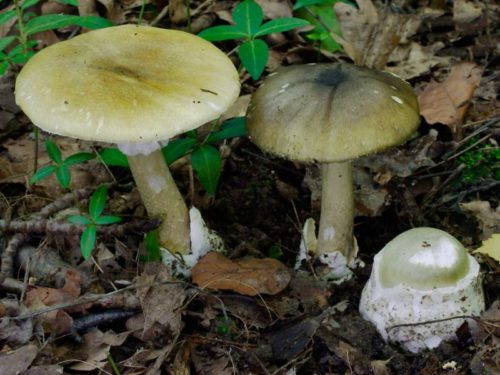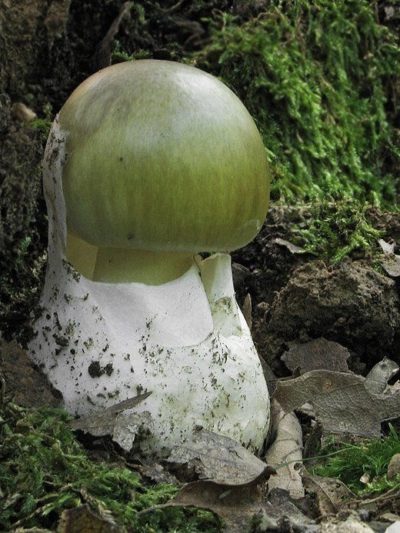
Among the known mushrooms, this is the most toxic for man. All parts of mushrooms, including spores are toxic. Toxins remain stable for several years. It is recommended to wash your hands well after working with this mushroom.
A hat: The color varies from yellowish to greenish-brown, with slight black radial lines. Size 7-12 cm in diameter. In his youth is round and a bell, and later flattened. The surface is sometimes slimy, smooth, rarely with some rest layer. Meat is white, greenish beneath the cuticle. Meat and leaves the influence of sulfuric acid changing the color white in bright purple.
Gills: The thick, white color with a tinge of green, they are free
Handle: Centric, the size of 8-12 cm, the top of the slightly tapered. It basically has tuberous expansion (bulb) located in white volva. Colour of the hilt is light greenish-yellow or white, smooth or with tiny husks. The upper part has a large, white, hanging ring.
Spores: In the group are white, individually colorless, oval, smooth. In the iodine solution becomes dark blue.
Smell: Dry clover, cookie. When old patterns smell is very unpleasant.
Taste: Pleasant
Prevalence: It grows singly or in groups, sometimes arranged in a ring, in the deciduous forests, especially in the forests of beech and oak, but also in coniferous and meadows on the edge of the forest.
Toxicity: Deadly. Phallotoxin reacts after 6-12 hours, causing stomach cramps and vomiting. This type of venom destroys partly during cooking, and partly gastric juice. Amatoxin reacts more slowly after 24-48 hours, usually after the victim recovers from the first symptoms, causing further deterioration in the health of patients. Diarrhea occurs, leading to dehydration of the tissue, then occurs and the yellowness and the painful spasms. The patient falls into a coma and dies (usually 3-5 days after eating mushrooms) in torment. Chance for patient recovery disposal of medical intervention from the moment meals is becoming smaller and largely depends on the general condition of a patient.

It is believed that over 90% of deaths caused by mushroom poisoning caused by Amanita species, including A. phalloides most important. Those who are lucky enough to survive, claim that is the mushroom very delicious to eat, and that there are no current signs of poisoning. The poison damages the liver and kidneys and reduces the possibility that the body gets rid of. It has been found that the amount of mushroom (1 cm3) sufficient to cause death. Amanita species should be avoided if there is no security in identifying mushrooms.
